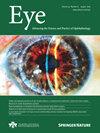睫状体上地塞米松植入治疗黄斑水肿的安全性和有效性:初步对比研究。
IF 2.8
3区 医学
Q1 OPHTHALMOLOGY
引用次数: 0
摘要
目的:对比玻璃体内(IV)地塞米松植入术的疗效和安全性,评价睫状体上腔(SC)是一种新的、潜在的有效植入术部位。方法:本前瞻性研究纳入38例黄斑水肿(ME)患者39眼,行SC和IV地塞米松植入(SC- dex和IV- dex)。患者随机分为治疗组,随访3个月。术前和术后评估包括最大视网膜厚度(MRT)、连续就诊之间中央视网膜厚度的变化(ΔCRT)、眼压(IOP)和最佳矫正视力(BCVA)。结果:SC-DEX组和IV-DEX组在随访期间均显示显著的MRT降低。在SC组,MRT在第1个月和第3个月显著下降(p = 0.0002),但在第1周没有下降(p = 0.2517)。IV-DEX组在所有术后随访中均观察到MRT显著降低:第1周(p = 0.0002)、第1个月(p = 0.0004)和第3个月(p = 0.0003)。SC-DEX组和IV-DEX组在任何访问时ΔCRT的变化均无显著差异(p < 0.05)。IOP无明显变化(p < 0.05)。与IV-DEX组相比,SC组的BCVA在第一周显著改善(p = 0.014)。两组患者均未出现其他围手术期或术后危及视力的并发症,包括眼内炎或眼内炎。结论:SC-DEX有望成为治疗ME的替代方案,具有与IV-DEX相似的有效性和安全性。需要进一步的研究来证实其长期的安全性和有效性。本文章由计算机程序翻译,如有差异,请以英文原文为准。

Safety and efficacy of supraciliary dexamethasone implantation for macular oedema: a preliminary comparative study
To evaluate the efficacy and safety of dexamethasone implantation in the supraciliary (SC) space, a novel and potential effective implantation site, compared to intravitreal (IV) application. This prospective study included 39 eyes of 38 patients with macular oedema (ME) who underwent SC and IV dexamethasone implantation (SC-DEX and IV-DEX). Patients were randomly assigned to treatment groups and followed for 3 months. Preoperative and postoperative assessments included maximum retinal thickness (MRT), change in central retinal thickness between consecutive visits (ΔCRT), intraocular pressure (IOP), and best corrected visual acuity (BCVA). Both SC-DEX and IV-DEX groups showed significant MRT reductions during at follow-up. In the SC group, MRT significantly decreased at 1st and 3rd months (p = 0.0002 for both), but not at 1st week (p = 0.2517). In the IV-DEX group, significant reductions in MRT were observed at all postoperative visits: 1st week (p = 0.0002), 1st month (p = 0.0004), and 3rd month (p = 0.0003). There were no significant differences in the change in ΔCRT between the SC-DEX and IV-DEX groups at any visit (p > 0.05). IOP did not show significant changes (p > 0.05). BCVA improved significantly in the SC group compared to the IV-DEX group during the first week (p = 0.014). No other perioperative or postoperative sight-threatening complications were noted in either group, including hypotony or endophthalmitis. SC-DEX shows promise as an alternative for managing ME, offering similar effectiveness to IV-DEX with safe profile. Further studies are needed to confirm its long-term safety and efficacy.
求助全文
通过发布文献求助,成功后即可免费获取论文全文。
去求助
来源期刊

Eye
医学-眼科学
CiteScore
6.40
自引率
5.10%
发文量
481
审稿时长
3-6 weeks
期刊介绍:
Eye seeks to provide the international practising ophthalmologist with high quality articles, of academic rigour, on the latest global clinical and laboratory based research. Its core aim is to advance the science and practice of ophthalmology with the latest clinical- and scientific-based research. Whilst principally aimed at the practising clinician, the journal contains material of interest to a wider readership including optometrists, orthoptists, other health care professionals and research workers in all aspects of the field of visual science worldwide. Eye is the official journal of The Royal College of Ophthalmologists.
Eye encourages the submission of original articles covering all aspects of ophthalmology including: external eye disease; oculo-plastic surgery; orbital and lacrimal disease; ocular surface and corneal disorders; paediatric ophthalmology and strabismus; glaucoma; medical and surgical retina; neuro-ophthalmology; cataract and refractive surgery; ocular oncology; ophthalmic pathology; ophthalmic genetics.
 求助内容:
求助内容: 应助结果提醒方式:
应助结果提醒方式:


